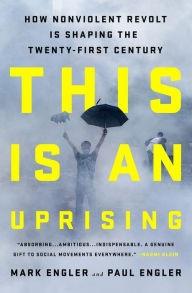
 Journalist and author Mark Engler (How to Rule the World) and organizer Paul Engler (founding director of the Center for the Working Poor in Los Angeles) argue that mass protests are not spontaneous eruptions, but "forces that can be guided with the exercise of conscious and careful effort." Drawing on vivid worldwide historical examples and interviews with scholars and organizers in the "tradition of strategic nonviolence," This Is an Uprising is a well-structured and engaging guide to "the art of unarmed uprising."
Journalist and author Mark Engler (How to Rule the World) and organizer Paul Engler (founding director of the Center for the Working Poor in Los Angeles) argue that mass protests are not spontaneous eruptions, but "forces that can be guided with the exercise of conscious and careful effort." Drawing on vivid worldwide historical examples and interviews with scholars and organizers in the "tradition of strategic nonviolence," This Is an Uprising is a well-structured and engaging guide to "the art of unarmed uprising."
The authors refute the idea that there is anything weak about nonviolent civil resistance, and provide strong evidence that nonviolent movements have been "twice as likely to succeed as violent ones" in both democracies and dictatorships. However, without substantial structure and funding, revolutionary movements often struggle to maintain and build on their achievements. Through the opposing ideas of Saul Alinsky and Frances Fox Piven, the authors examine the tensions between disruptive underfunded fringe groups and established organizations, such as unions and large nonprofits, which hesitate to take radical action for fear of risking their hard-won investments and political alliances. They then tell the story of the Serbian resistance group Otpor, which created "a hybrid between structure and mass protest," that with great creativity, humor and discipline achieved the democratic removal of Slobodan Milošević. Gandhi, King and same-sex marriage activists in the U.S. also attempted to create hybrid models, with varying success.
The authors reflect on what triggers uprisings, and how organizers may take advantage of such moments of "whirlwind." Organizer Judi Bari's work with Earth First! illustrates the effectiveness of nonviolent strategies compared with violent ones in the same context, and other examples show the self-destructive effects of violent revolutionary action. They consider the value of both material gains and symbolic success, and how success may be evaluated and celebrated (or not).
"Strategic nonviolence does not offer a secret formula for success, and its development is hardly the work of a single mastermind. Rather, the growth of civil resistance has been the result of practitioners experimenting in diverse and difficult conditions, adding their own refinements to an art that has been developing for a century." Engler and Engler have distilled decades of complex and often discordant theories into an accessible guide to effective lasting civil resistance and organization building. This is a book that is likely to be read and reread for years to come. --Sara Catterall
Shelf Talker: The history and key ideas of nonviolent revolt are distilled into an essential guide to the most effective strategies for creating lasting social change.

